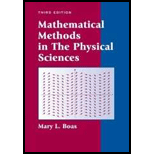
For these problems, the most important sketch is the projection in the plane of integration, which is easy to do by hand. However, you might like to use your computer to plot the corresponding 3 dimensional picture.
For a uniform mass distribution over the area of Example 1, find the moment of inertia about the z axis.
Want to see the full answer?
Check out a sample textbook solution
Chapter 5 Solutions
Mathematical Methods in the Physical Sciences
Additional Math Textbook Solutions
The Heart of Mathematics: An Invitation to Effective Thinking
A Problem Solving Approach To Mathematics For Elementary School Teachers (13th Edition)
Excursions in Modern Mathematics (9th Edition)
Mathematics with Applications In the Management, Natural and Social Sciences (11th Edition)
Calculus for Business, Economics, Life Sciences, and Social Sciences (14th Edition)
Fundamentals of Differential Equations and Boundary Value Problems
- Suppose that r=12 cm and h=15 cm in the right circular cylinder. Find the exact and approximate a lateral area. b total area. c volume.arrow_forwardSolve these prism and cylinder exercises. Where necessary, round the answers to 2 decimal places unless otherwise specified. A solid right cylinder 9.55 centimeters high contains 1910 cubic centimeters of material. Compute the cross-sectional area of the cylinder.arrow_forward
 Elementary Geometry For College Students, 7eGeometryISBN:9781337614085Author:Alexander, Daniel C.; Koeberlein, Geralyn M.Publisher:Cengage,
Elementary Geometry For College Students, 7eGeometryISBN:9781337614085Author:Alexander, Daniel C.; Koeberlein, Geralyn M.Publisher:Cengage, Mathematics For Machine TechnologyAdvanced MathISBN:9781337798310Author:Peterson, John.Publisher:Cengage Learning,
Mathematics For Machine TechnologyAdvanced MathISBN:9781337798310Author:Peterson, John.Publisher:Cengage Learning,

